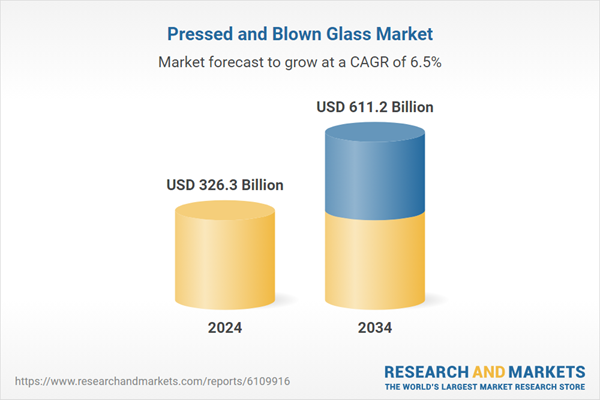Glass is increasingly favored for its functional versatility and visual appeal in modern design, with shifting consumer preferences emphasizing both performance and aesthetics. In sectors like packaging and interiors, durable and recyclable glass materials are replacing less sustainable alternatives. Additionally, technological upgrades in automated blowing and pressing processes allow manufacturers to produce at scale while meeting custom requirements. Advanced tools like AI-integrated monitoring and robotic forming are gaining traction, improving production outcomes and quality control.
European and North American operations have embraced automation, enhanced speed and efficiency, and helping companies meet rising consumer expectations. The market is further supported by ongoing investments in eco-conscious production methods, as the industry aligns itself with global sustainability goals. Blown glass is gaining traction due to rising demand for personalized and high-end decorative products. Meanwhile, pressed glass remains a dominant material in container manufacturing, playing a crucial role in industries such as pharmaceuticals, beauty, and beverages.
The tableware segment held the largest market share in 2024, generating USD 121.2 billion, and is projected to hit USD 229.8 billion by 2034, growing at a CAGR of 6.7%. Glass tableware - including drinkware, plates, and serving items - continues to be in high demand for its hygiene, thermal resistance, and long-term usability. The movement toward environmentally friendly dining habits is steering consumers away from plastics and ceramics. Design trends favoring artisan craftsmanship and minimal, transparent serveware have helped accelerate glass tableware sales in key markets such as North America and Europe.
The household and interior décor category captured a 37.1% share in 2024. This growth is being fueled by urban development, increased interest in modern living aesthetics, and custom orders for multifunctional decorative pieces. Items like glass vases, lighting fixtures, art pieces, and accent panels are seeing a rise in popularity, especially those that are handcrafted or sustainably produced. Consumer preference for long-lasting, eco-friendly interior elements is promoting greater use of both pressed and hand-blown designs across several regions including parts of Asia-Pacific, Europe, and North America.
China Pressed and Blown Glass Market generated USD 52.7 billion in 2024 and is expected to grow at a CAGR of 6.7%, reaching USD 100 billion by 2034. This expansion is tied to rising consumption, improvements in mechanized manufacturing, and a transition to more intelligent production systems. Chinese producers are placing greater emphasis on sustainability, integrating more recycled cullet into production to cut costs and minimize environmental impact. Younger generations are shaping trends in custom and digital glassware, fostering demand for unique aesthetics and functional elegance.
Leading players in the market include Krosno Glass S.A., Libbey Inc., Arc Holdings, Bormioli Rocco, and Pasabahce under the Sisecam Group. Major companies in the pressed and blown glass market are prioritizing technological integration to enhance productivity and reduce errors. Robotic forming systems and AI-powered quality inspection tools are being widely deployed to improve consistency and cut production time. To meet the growing demand for sustainable solutions, many firms are shifting toward using recycled raw materials and adopting energy-efficient processes. Investments in digital design platforms allow these brands to quickly prototype and customize products, catering to both industrial clients and design-conscious consumers. Strategic partnerships with designers and retail distributors further enable companies to stay ahead in style and function.
Comprehensive Market Analysis and Forecast
- Industry trends, key growth drivers, challenges, future opportunities, and regulatory landscape
- Competitive landscape with Porter’s Five Forces and PESTEL analysis
- Market size, segmentation, and regional forecasts
- In-depth company profiles, business strategies, financial insights, and SWOT analysis
This product will be delivered within 2-4 business days.
Table of Contents
Companies Mentioned
- Anchor Hocking LLC
- Arc International
- Ardagh Group S.A.
- Beatson Clark Ltd.
- Bormioli Rocco S.p.A.
- Borosil Limited
- Garbo Glassware Co., Ltd.
- Gerresheimer AG
- Glass Dynamics LLC
- Kopp Glass, Inc.
- Libbey Inc.
- O-I Glass, Inc. (Owens-Illinois)
- Piramal Glass Limited
- Rayotek Scientific Inc.
- Saverglass SAS
- SCHOTT AG
- Sisecam Group
- Steelite International
- Stoelzle Glass Group
- Verallia
- Vetropack Holding Ltd.
- Vidrala S.A.
- Vitro, S.A.B. de C.V.
- Wiegand-Glas GmbH
- Zwiesel Kristallglas AG
Table Information
| Report Attribute | Details |
|---|---|
| No. of Pages | 225 |
| Published | June 2025 |
| Forecast Period | 2024 - 2034 |
| Estimated Market Value ( USD | $ 326.3 Billion |
| Forecasted Market Value ( USD | $ 611.2 Billion |
| Compound Annual Growth Rate | 6.5% |
| Regions Covered | Global |
| No. of Companies Mentioned | 25 |









